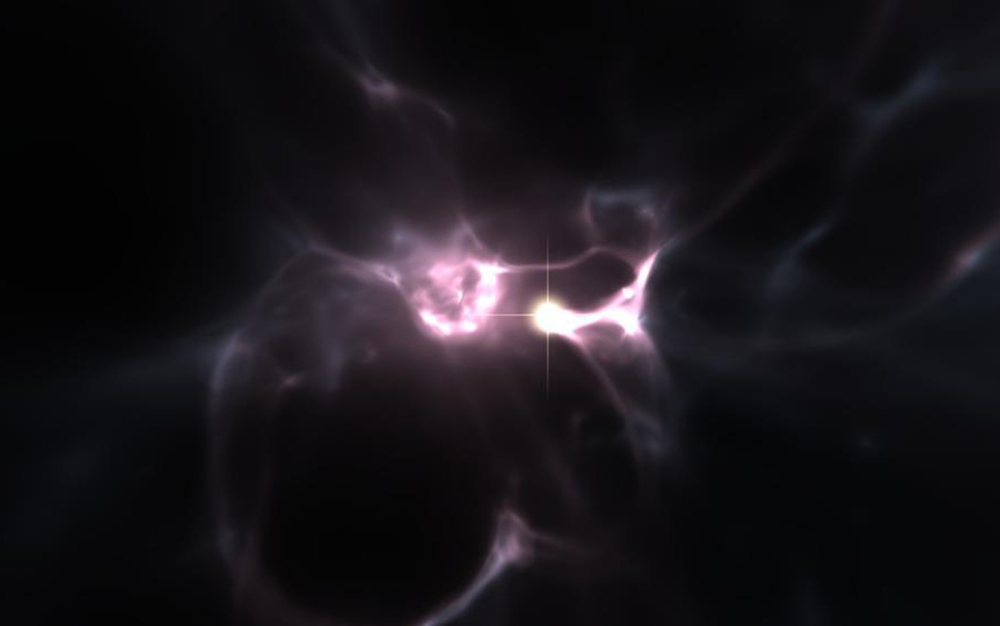Bits of Corpse from One of the Universe's Oldest Stars Found Inside Its 'Child'

Astronomers have detected evidence of one of the first stars to emerge after the Big Bang birthed the universe 13.8 billion years ago.
They found traces of an exploded, ancient star tucked inside a star that's nearly as old. Located about 35,000 light-years from Earth on the other side of the Milky Way, the younger star — an iron-poor red giant — took shape after its short-lived parent exploded in a supernova, researchers reported in a new study.
When the scientists analyzed the elements in the Milky Way star, they found a pattern that matched simulations of what would remain after the explosive death of one of the oldest stars in the universe. [15 Unforgettable Images of Stars]
"We've found a time machine that takes us back to the universe's earliest stars," lead study author Thomas Nordlander, an astronomer with Australian National University, said in a statement.
Studies of the infant universe suggest that the first stars emerged from clouds of dust and gas around 200 million years after the Big Bang, according to NASA. However, some models have hinted that star birth began even earlier, when the universe was only 30 million years old, Live Science's sister site Space.com reported in 2006.
First-generation stars, known as Population III stars, were metal-free and enormous; they are estimated to have been as much as 100 times as massive as our sun, the study authors reported. Because these stars were so gigantic, they were also short-lived. Astronomers search for signs of those stars today in element traces that were ejected when the ancient stars died in spectacular supernova explosions, according to the study.
The stellar parent of the Milky Way star wasn't that big; it was likely only about 10 times the size of the sun, and its supernova was "fairly feeble," Nordlander said. In fact, the star's death was so lackluster that the elements generated by the supernova didn't travel far. After the explosion, most of the heavier elements were sucked back into the dense neutron star — the collapsed core of the dying old-timer — that was left behind.
Get the Space.com Newsletter
Breaking space news, the latest updates on rocket launches, skywatching events and more!
However, a tiny amount of elements heavier than carbon managed to escape. These elements were incorporated into a new star — "the very old star that we found," Nordlander explained.
Scientists discovered the Milky Way star, named SMSS J160540.18−144323.1, in a survey conducted with the SkyMapper telescope, a wide-field optical instrument at Siding Spring Observatory in northern New South Wales, Australia.
When the researchers examined the low-metal star, they found that the amount of elements heavier than carbon was "remarkably low" and its iron content was the lowest ever measured in a star: 1 part per 50 billion, which is about 1.5 million times lower than the iron content of the sun, the researchers wrote.
"That's like one drop of water in an Olympic swimming pool," Nordlander said.
The exceptionally low concentrations of both heavy elements and iron hint that the star formed when the universe was young, most likely soon after the very first generation of stars began to die out, according to the study.
While it is unlikely that any of the universe's earliest stars have survived, stars such as this "anemic" Milky Way red giant offer a glimpse of their long-dead parents, said study co-author Martin Asplund, a chief investigator with the Australian Research Council's Centre of Excellence for All Sky Astrophysics in 3 Dimensions (Astro 3D).
"The good news is that we can study the first stars through their children — the stars that came after them, like the one we've discovered," Asplund said in a statement.
The findings were published online July 17 in the journal Monthly Notices of the Royal Astronomical Society: Letters.
- Spaced Out! 101 Astronomy Photos That Will Blow Your Mind
- 11 Fascinating Facts About Our Milky Way Galaxy
- Amazing Astronomy: Victorian-Era Illustrations of the Heavens
Originally published on Live Science.
Join our Space Forums to keep talking space on the latest missions, night sky and more! And if you have a news tip, correction or comment, let us know at: community@space.com.











